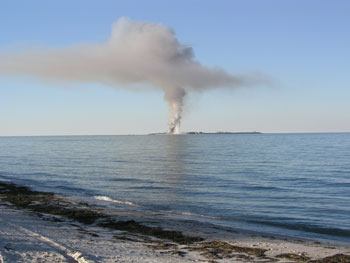
A huge column of smoke rises from the south end of Egmont Key
during last week’s controlled burn.
PHOTO/ED ICE
EGMONT KEY – A controlled burn on Egmont Key last week startled some Anna Maria Island residents and displaced gopher tortoises that make their homes on the key.
The burn of the southern third of the key eliminated dead trees and non-native vegetation, including Australian pines, according to one of the park’s rangers, Ivan Vicente.
The burn was intended to clear the sand of exotic vegetation and open up more space for birds that nest in the sand, such as the royal tern and sandwich tern, he said.
Several bird species including black skimmers, American oystercatchers and brown pelicans nest on the southern part of the key, which is a sanctuary, in spring and summer, he said, adding that the birds are gone now.
The burn also will encourage the growth of native vegetation, he said.
"This will help spread sea oats and regenerate vegetation that controls erosion. Fire is an important part of habitat management."
The key also is home to more than 1,500 threatened gopher tortoises, a unique colony that is free from an upper respiratory disease that plagues mainland tortoises.
A dozen volunteers gathered up as many of the tortoises as they could find in two days and moved them in trucks to the north side of the key to minimize mortality, Vicente said, adding that he did not know how many tortoises were moved. Some box turtles also were relocated.
Box turtles are vulnerable to fires, but for gopher tortoises, the move probably was unnecessary, stressful and could result in them not finding their burrows again, said Ray Ashton of the Ashton Biodiversity Research and Preservation Institute in Archer, Florida, a consultant for the state’s tortoise relocation efforts.
"Gopher tortoises are astute about fire," he said. "If there’s smoke, they respond by going to their burrows, where they’re protected."
Ashton described a tortoise behavior he witnessed and videotaped during a controlled burn. A tortoise walked along the fire line until it found a break in the fire, then took the exit through the burned-out ground back to its burrow.
Moving the animals away from their burrows and not replacing them could do more damage than if they had been left alone, he said.
The key at the mouth of Tampa Bay, accessible only by boat, is home to the Egmont Key National Wildlife Refuge, established in 1974.
It is also the base for the Tampa Bay Pilot’s Association, whose harbor pilots guide ships in and out of Tampa Bay’s shipping channels. A working lighthouse that dates back to 1858 and a park manager’s home also are on the key, along with the U.S. Army’s Fort Dade Military Reservation ruins, a popular destination for boaters.
The fort was used by the Army to detain Seminole prisoners at the end of the third Seminole War in 1858. It was occupied by both Confederate and Union troops during the Civil War, and later became the site of Fort Dade, built to defend against Spanish attack during the Spanish-American War.
Egmont Key was named for John Perceval, the second Earl of Egmont and a member of the Irish House of Commons in 1763.



